| Year | Population |
|---|---|
| 1970 | 6,593 |
| 1980 | 11,282 |
| 1990 | 13,020 |
| 2000 | 14,904 |
| 2010 | 17,001 |
| Geographic Data | |
|---|---|
| N. Latitude | 43:47:50 |
| W. Longitude | 70:24:18 |
| Maine House | Dist 24,25 |
| Maine Senate | District 26 |
| Congress | District 1 |
| Area sq. mi. | (total) 50.3 |
| Area sq. mi. | (land) 46.7 |
| Population/sqmi | (land) 364.5 |
County: Cumberland
Total=land+water; Land=land only |
|
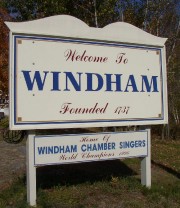 [WIND-uhm] is a town in Cumberland County, settled in 1735 and incorporated on June 12, 1762 from New Marblehead Plantation.
[WIND-uhm] is a town in Cumberland County, settled in 1735 and incorporated on June 12, 1762 from New Marblehead Plantation.
A mill was erected on the Presumpscot River at Mallison Falls (also known as Horseshoe, Horse Beef, and Nagwamqueeg) as early as 1738.
Native Americans protested that is was preventing the migration of fish, on which they depended. The dam and associated mill was washed away in a flood in 1743. The river flows the length of the town from Sebago Lake Basin to Westbrook in the south.
As with most early Maine towns, life was dangerous. According to George Varney,
In 1744 a substantial fort was erected in the settlement, and furnished at the expense of the inhabitants with two swivel guns and the necessary ammunition. From 1745 to 1751 the inhabitants lived within its walls. It was a period of great suffering and danger . . . .
Population levels from 1820 through 1940 remained at about 2,000. After World War II, it began to inch upward, but by the 1970s the community began to change dramatically. Windham had almost tripled its population by 2010.
The main village, North Windham, lies adjacent to Sebago Lake and on the shore of Little Sebago Lake at the junction of U.S. Route 302 and Maine Routes 35 and 115.
The lakes are an attraction for summer vacations. AIMHI Lodge, established in the early 20th century, was such an attraction until 2007 when it closed.
While Route 302 is a long commercial strip, the old meeting house above is adjacent to the Windham Union Church. Built in 1849, the Friends Meeting House (below) is on Route 4 in South Windham.
The Maine Correctional Center (MCC) on the Mallison Falls Road is a Medium/Minimum Security facility and houses both male and female prisoners. The Southern Maine Women’s Re-Entry Center is nearby on the River Road.
Windham’s historic lore includes these items:
-
- Resident John A. Andrews was an early governor of Massachusetts
-
- The first church was organized in 1743
- Nineteen schoolhouses were operating in 1886
Form of Government: Town Meeting-Council-Manager.
Additional resources
Bodge, George M. New Marblehead, Now Windham, Me.: Ecclesiastical Matters. 1898. [Maine State Library]
Dole, Frederick Howard. Sketches of the History of Windham, Maine, 1734-1935; The Story of a Typical New England Town. Westbrook, Me. H. S. Cobb, Printer. 1935.
Dole, Samuel Thomas. Windham in the Past. Windham, Me. Windham Historical Society. 1974. [Maine State Library] (A source for “Horseshoe Dam” date.)
French, George. “Roadside Vegetable Stand, North Windham (1938).” George French Collection, Maine State Archives.
Friends of Sebago Lake, Friends of the Presumpscot River and American Rivers. “Historic Records Related to the Anadromous Fisheries of the Presumpscot River and Sebago Lake, Maine.” September 2002. http://home.gwi.net/~fks/presumpoverview.html (accessed October 29, 2013)
*Maine. Historic Preservation Commission. Augusta, Me. Text and photos from National Register of Historic Places: http://pdfhost.focus.nps.gov/docs/nrhp/text/xxxxxxxx.PDF and http://pdfhost.focus.nps.gov/docs/nrhp/photos/xxxxxxxx.PDF
Goold Family House: 89000251.PDF
Great Falls Historic District: 94001541.PDF
Maplewood Farm: 91001813.PDF
Parson Smith House: 73000237.PDF
Smith, Thomas Laurens. History of the Town of Windham. Portland, Me. Hoyt & Fogg. 1873.
Varney, George J. A Gazetteer of the State of Maine. 1886. p. 592.
Windham Bicentennial Committee, Windam, Me. Windham 1976. The Bicentennial Committee. Windham, Me. The Committee. 1976. [University of Maine, Raymond H. Fogler Library, Special Collections; Maine State Library]
Windham, Maine 250th Anniversary Celebration June 1987. 1987? North Windham, Me. The Village Print Shop, Courier Free Press. [Maine State Library]
National Register of Historic Places – Listings
Goold House
[280 Windham Center Road] The Goold Family House is a 1 ½-story Greek Revival dwelling, home to William Goold, a noted Maine historian and author, and where he wrote between 1861-1890.
Known to those who read his Portland Press newspaper column as “W.G.”, he was born in Windham on the Goold farmstead on April 13, 1809, though probably not in the house where he wrote years later.
Son of Nathan and Betsey (Gowen) Goold, William’s schooling had been limited. Apparently when William left home to begin apprenticing, he carved the date 1823 in the stone behind the present house. In 1834 Goold married Nabby Tuckey Clark, daughter of William Goold’s employer Seth Clark, the first Portland merchant tailor with whom Goold apprenticed. He was later employed in both Portland and Biddeford.
In 1861, Goold returned to the family farm in Windham where he took up farming, while living in the Greek Revival dwelling that still stands. He became a State Senator in 1874-75, but his real passion was history, and in 1871 Goold published his first historical article for the Press. He was elected a member of the Maine Historical Society in 1873 and became its recording secretary. Between 1873 and 1889, Goold delivered fourteen papers before the Society on a variety of topics including historic buildings, figures and events. In addition to countless newspaper articles, Goold wrote the important Portland history, Portland in the Past (1886).* (Kirk F. Mohney B&W photo)
Great Falls Historic District
[Along Old Great Falls Road, East of the Presumpscot River in North Gorham, a village in the Town of Windham; N43° 48′ 8.11″ W70° 26′ 53.03″.] The Historic District includes one late 18th century house, two houses dating from the first half of the 19th century, and several industrial mill sites. They survive from a period when Great Falls was a thriving rural mill hamlet on the Presumpscot River. Although Euro-American settlement apparently began in Windham as early as 1737, development at Great Falls probably began in the 1780s when Zebulon Trickey purchased mill privileges. By 1788, a bridge linked North Gorham with the Windham side of Great Falls when saw mills were operating on both sides of the river.
Zebulon Trickey’s son John apparently operated the mill for his father and lived on the 100 acre Lot 124, now the Pringle estate, in 1791. The two story Federal house here was apparently built several years later. By 1800, there were thirteen families living on both sides of the river at Great Falls with a total population of 53 people. The establishment of saw mills probably encouraged settlement and provided building materials and extra work for local farmers. When John Trickey died in 1811, his mill privilege was transferred to his bother-in-law John White. John White operated the family farm and mill for the next twenty years. The White mill, as it came to be known, was among the first in the state to employ the “gang saw” method of milling wood about 1830. The Peter Trickey House, located just to the northwest of the Trickey-White House is typical of the Federal period and was probably built sometime around 1820.
In 1832, John White sold the mill privilege to his son Enoch, who served in the State legislature from 1836 to 1846. In the decade between 1835 and 1845 the amount of white pine on the Presumpscot was enormous, with the surface of the river often being a solid bridge of logs. The lumber mills in operation at Great Falls during these years apparently thrived, with small fortunes being made by mill owners on both sides of the river. The population of the area grew markedly with the advent of the Oxford and Cumberland Canal and the jobs and commerce it produced in the area.To a large extent, the mid-19th prosperity of Great Falls appears to have been made possible by the existence of the canal which functioned as an efficient, inexpensive transportation route to the Portland market and beyond. The slow decline of the canal, and its eventual abandonment in 1882, probably hastened to the economic stagnation of Great Falls during the late 19th century. Despite some alterations in the landscape, the Great Falls Historic District survives as a relatively intact example of an industrial hamlet in the rural landscape of Maine. It clearly illustrates the importance of this community and the prosperity it achieved during late 18th to mid-19th century.* [Kirk F. Mohney B&W photos]
Maplewood Farm
[River Road southeast of junction with Webber Road South Windham; N43° 42′ 54.81″ W70° 23′ 28.23″] This farm in South Windham has significant historical and architectural associations. First settled by Abraham Anderson in the early 18th century, it contains a house built in the 1770s and remodeled in the mid-19th century into its present, Gothic Revival form. Set in a picturesque grove of shade trees and curving drives, the house lies adjacent to a barn and series of stone walls. In the mid-19th century the house became the center of a farm developed by John F. Anderson, a notable agriculturalist and civil engineer.
Apparently the original house on this property was built for Edward Anderson (1753-1804). Edward was the son of Abraham Anderson (1705-1768) who acquired the property in 1738, but lived on an adjacent parcel. Abraham and his wife Anna are buried in the cemetery on the grounds. In 1774 Edward Anderson married, having come into possession of the “home farm” upon his father’s death. Probably the original two-story Edward Anderson house dates from the late 1770s or early 1780s. In 1790 Edward exchanged the farm for his brother Abraham’s property near Windham Hill. Eventually, the homestead was acquired by John Anderson (1792-1853).
A former State Senator (1824), member of Congress (1825-1833), U. S. Attorney (1833- 1836), and Mayor of Portland (1833-1842), John Anderson apparently used the Windham property as a summer home. A local historian, wrote in 1916 that John Anderson “expended large sums in improvements” on the property, implying that the Gothic remodeling may have been carried out by him between 1844 and 1853.
John Anderson’s son John Farwell Anderson (1823-1887) distinguished himself both as a civil engineer and in the field of agriculture. A graduate of Gorham Academy, Anderson studied engineering under William Anson of Portland and Capt. Green of the Army Corps of Engineers in Tyngsboro, Massachusetts. He later became assistant engineer (1843) in the North East Boundary Survey; assistant engineer (1847) on the Androscoggin and Kennebec Railroad; engineer (1850) of the Portland and Kennebec Junction Railroad; chief engineer (1851-1853) of the York and Cumberland Railroad; and city engineer (1852) of Portland. His significant association with the family homestead began in 1853, after his father’s death. Among the improvements he made was the establishment of a herd of Devonshire cattle, for which he gained statewide recognition.* (Kirk F. Mohney photos)
Smith, Parson, House
[Southeast of South Windham on River Road South Windham; N43° 42′ 59.47″ W70° 23′ 32.78″] The Parson Smith House is one of the finest examples of colonial architecture in Maine. It is in excellent condition and has been virtually unchanged since its construction in 1764. The builder, Peter Thatcher Smith, was the second son of the Rev. Thomas Smith of Falmouth (now Portland). Peter was born in 1731 and took his first degree from Harvard College in 1753. He taught for a few years in Weymouth, Massachusetts while studying for the ministry.
Smith had preached occasionally in Windham and in November 1761 was asked to settle there as permanent minister. He was ordained on September 22, 1762 in Windham and built his home in 1764 on “the Ministerial Lot” so called. Parson Smith lived in Windham until his death in 1826. A highly regarded clergyman, he once served as Representative to the General Court of Massachusetts in 1803.* (Richard D. Kelly B&W photo)



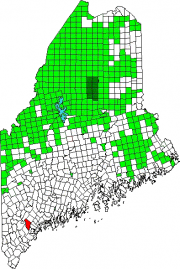

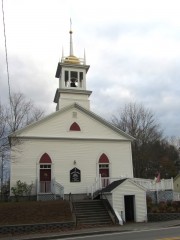

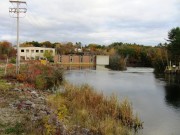
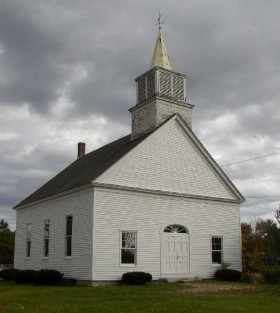
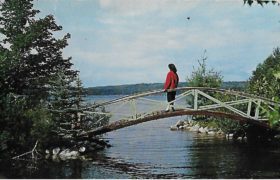
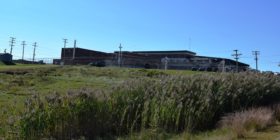
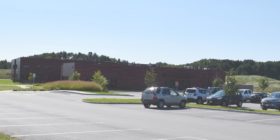
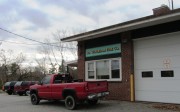
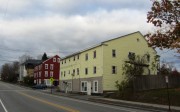
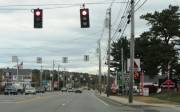
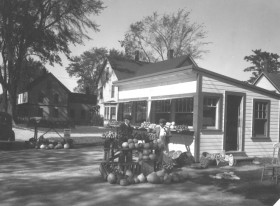
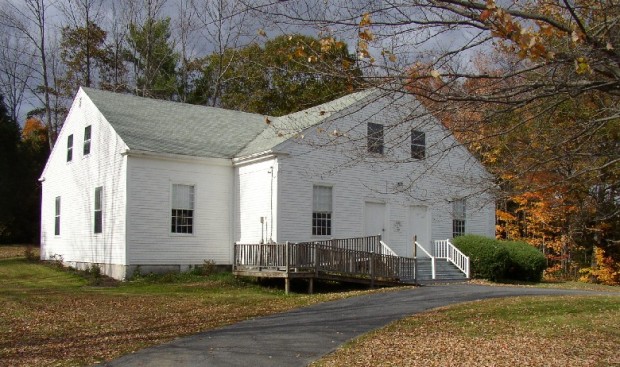
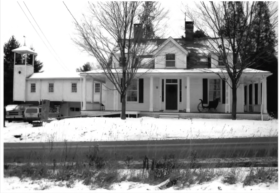
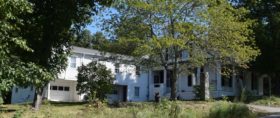

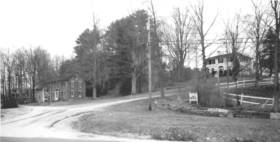
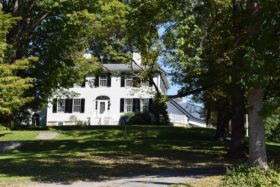

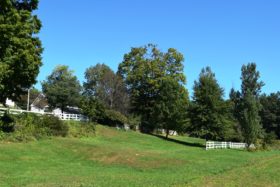
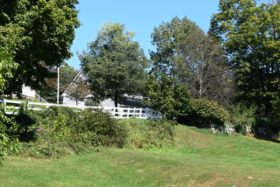
![Enoch White [l] Peter Trickey [r]Houses (1994) Enoch White [l] Peter Trickey [r]House (1994)](https://maineanencyclopedia.com/wp-content/uploads/Windham-Peter-Trickey-House--280x194.png)
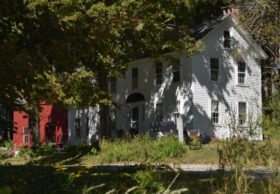
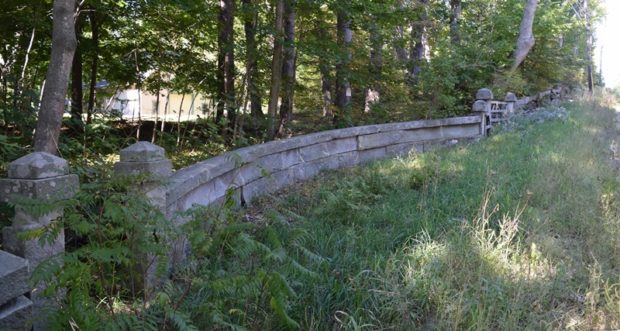
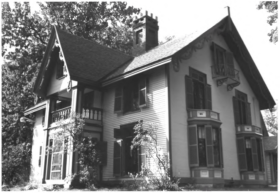
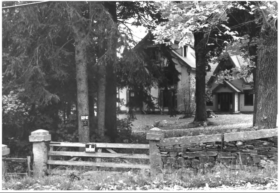
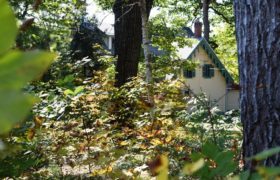
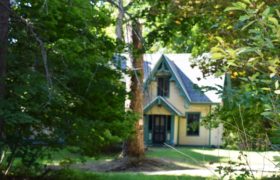
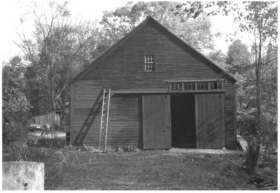
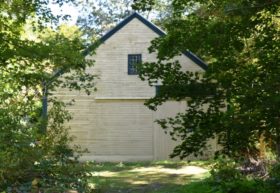

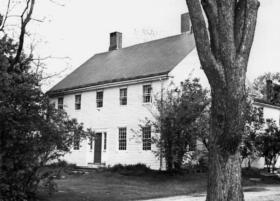

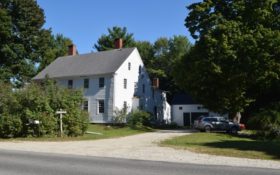
In South Windham on High st. Was called ,I think, Red City. Houses were used by the workers at the Pulp Mill. My dad worked at the mill and grew up on Depot road where a Wescott lived when I grew up. Am I right about ” Red City” ? Please set me straight.